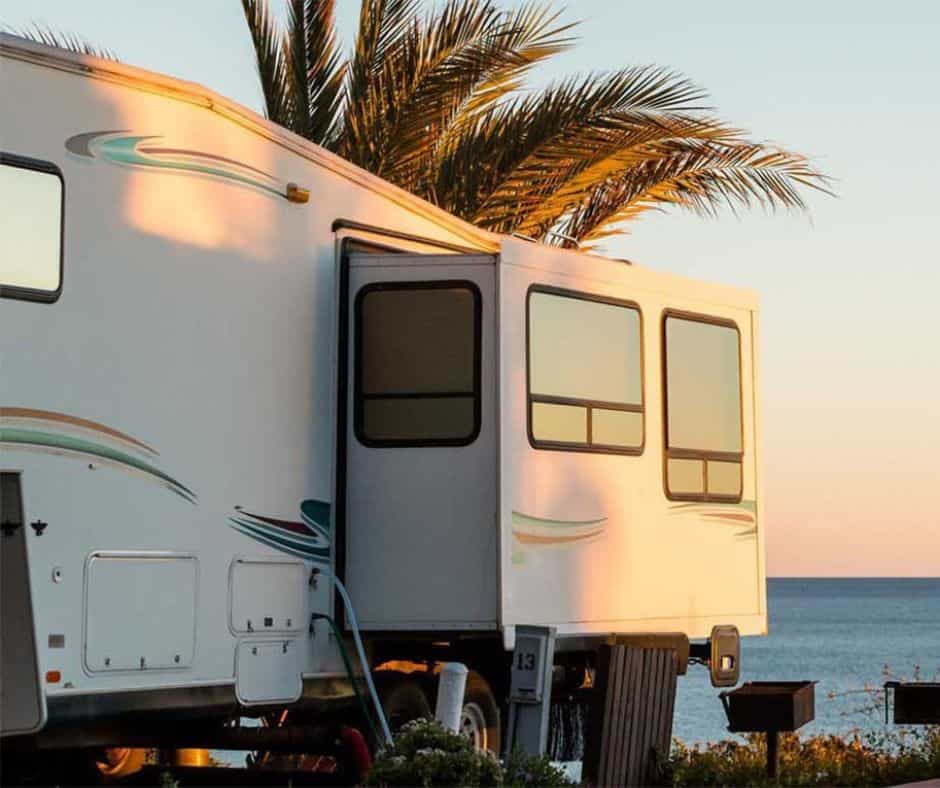An RV is a thrilling way to answer the call of the open road, while still being able to bring the comforts of home with you.
Of course, knowing the dimension of your RV and developing a relationship with how it handles plays an important role in delivering you the most stress-free adventure.
This includes knowing just how wide, tall and long your RV is for doing things like taking tight turns or backing into a narrow campsite.
Not to mention the DMV will need to know the width of your RV when you register it. If it is wider than state regulations allow, your RV might not be deemed road worthy.
Considering it’s such an important factor, we decided to take a closer look at RV widths and how wide can your RV legally be?
This included things like how the average width can change by RV type, as well as the information you need to give the DMV when you register your new RV.
How Wide Is an Average RV?
The width of a typical RV varies from 96″ to as much as 102″ wide. Though this is the chassis and body width, which doesn’t include mirrors as well as any other safety equipment.
How Wide Is an RV With Its Slides-Out?

When it’s extended the average slide-out adds roughly 3 to 4 feet to the width of an RV. If you have multiple slideouts on different sides, this added width is doubled.
A travel trailer with dual, opposing power slide-outs might need as much as 6 to 8 additional feet of width once you back it into a campsite or a tight slip at an RV park.
Does Legal RV Width Vary From State To State?
Most states set the road-legal limit width of an RV at a 102-inch maximum. Though there are a few that have tighter restrictions.
Hawaii is the only state with a 9-foot width restriction. However, there are some with 8-foot limits that are closely enforced. Especially during peak travel times of the year at state borders.
States with an 8-foot RV Width Restriction
How Do I Find The Width of My RV?

Your owner’s manual should have the width information and all other necessary measurements and ratings for our RV.
If you lost your RV’s owner’s manual you might be able to find it printed on a permanent sticker near the driver’s side door well of a motorhome or in the kitchen area.
You can also search online, just make sure to include the make, model, and floor plan of your RV. A VIN search can also turn up key specs for most RV models.
Why Do I Need to Know the Width of My RV?
You need to know the accurate width of your RV when you register it with your state’s Department of Motor Vehicles.
If the width specification doesn’t meet the state’s size restrictions you most likely won’t be able to legally register the RV as being road legal.
The DMV is very specific about these requirements and won’t let you gloss over them.
Of course, knowing the width of your RV also applies to practical safety reasons. Some RV parks and campgrounds have their own width restrictions for pull-thru or back-in sites.
Especially for primitive campgrounds where mother nature dictates the dimensions of dirt roads, pad placement, and campsite dimensions.
RV width can also be a factor when it comes to crossing narrow bridges or tight road width restrictions.
While you don’t run into this very often in the Western United States, it is a somewhat common issue when it comes to the narrow roads in the original 13 colonies as well as older parts of Eastern Canada.
Though even a particularly tight fast-food drive-thru in Montana might still catch you by surprise if you don’t know the accurate width of your RV.
Knowing the width of your RV is also a factor if you are going to cover it when it’s in storage.
While there are some sloppy universal covers, you generally cannot slip an 8-foot RV cover over an RV that is 9 feet wide.
It can also be practical for measuring for a protective cover. Or to ensure your vehicle is going to get through specific clearances.
How Do I Measure the Width of My RV?

Fortunately, measuring the width of your RV is as easy as measuring from one side of the RV to the other. Just make sure that you are measuring the widest part of the RV.
For purposes of registering your RV and meeting any state width regulations, you don’t have to measure things like mirrors, light covers, or the width of the RV with the slide-outs extended or the awning opened. Though it’s good to know these measurements.
More than one careless RV owner has found themselves taking off a mirror in a fast-food drive-thru, or unable to extend their slide-outs in an overly narrow campsite.
When you consider that it doesn’t take all that long, it’s well worth the time to have that information written down on a handy sheet of paper in the RV. Then take a picture of it to keep on your phone.
RV Measurements Worth Knowing
Not only will knowing these measurements help ensure you meet all road-legal requirements and state DMV registration requirements, but it can also give you the peace of mind that comes with knowing your RV will safely fit in a campsite.
These measurements will also come in handy if you need to buy an aftermarket cover to tightly fit your RV in winter storage.
Does RV Width Change By RV Type?

The average width of an RV can vary by type. Especially when it comes to the three different classes of motorhome.
How Wide Is The Average RV Campsite Pad?
Most RV campsites have a concrete or tamped gravel pad that is 9′ wide by 18′ long, which will accommodate most RVs.
Though many Class C, a lot of fifth-wheel trailers, and almost all Class A motorhomes need a larger site, which is why a lot of RV parks and campgrounds offer special campsites rated for them.
Many are pull-thru sites, which spare you having to back up a big rig.
How Wide Does A Garage Door Need To Be To Fit An RV?
If you have access to a commercial garage, barn, or RV storage site, then you will need to make sure that the door width matches the width of your RV.
If you have a big rig, you want a door that is roughly 10-feet wide to let you back in comfortably, with enough wiggle room to make some adjustments.
Conclusion
Knowing the width of your RV is important in a lot of different ways. For starters you need to report the accurate width, without the slide-outs extended when you register your RV with the DMV.
If your RV is too wide for your home state’s regulations, it might not be considered road legal.
You also need to know how wide your RV is when you take it on the road, and choose your campsite.
Width restrictions can be very difficult to get out of once you get yourself in too deep. Not to mention some of the RV campgrounds that pack units in like sardines.
When you know how wide your RV is with and without the slides extended you can make wiser choices about the campsite you choose as well as finding the safest possible path to get there.






